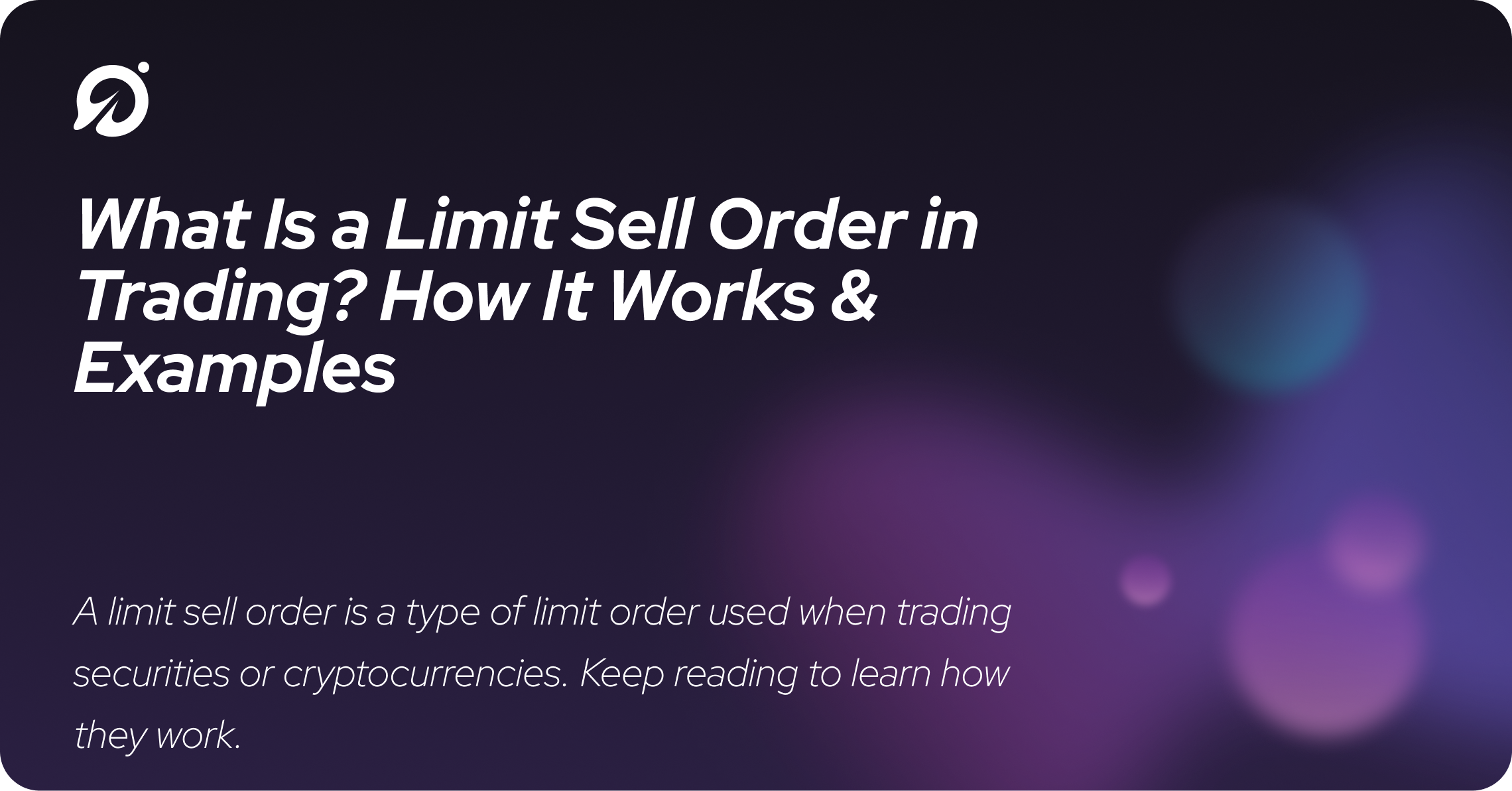What Is a Limit Sell Order in Trading? How It Works & Examples
A limit sell order is a type of limit order used when trading securities or cryptocurrencies. Many use limit orders to sell at a certain price level or better.

Disclaimer: This is for informational purposes and is not meant to serve as financial or investing advice.
Remember, a market order is a buy or sell that executes at what the market price of the asset is at the time it’s placed.
When the trader places a limit order, they tell the order book only to execute the order at the set price or better. That price point is called the limit price.
These are different from stop-loss orders because the trade will only execute at the limit price or better, whereas a stop-loss executes at the market price once a trigger has been reached.
Limit orders are good ‘til canceled or GTC, meaning if they aren’t filled, they will remain open orders until the trader takes them off the books.
Read our guide on stop limit orders to learn the difference between stop orders and limit orders.
How Are Limit Sell Orders Used?
A buy limit order executes at a specific price or lower. A sell limit order executes at a specific price or higher. Think of it as the minimum price you will accept, or you won’t take the trade.
Let’s say you have 2 Bitcoin you want to sell. The market price is $15,000, but you want to sell for a better price than the market price without sitting around at your computer all day.
You would set a limit order at $15,500. Your limit order would only fill if the price reaches or exceeds $15,000; the whole trade can be filled above that price.
When and Where Should You Trade Limit Orders?
Limit Sells and Stocks
Stock traders can use limit orders on their brokerage trading platform, setting limit orders on particular stocks. Smart traders on the stock market use limit orders to get the best price every time they trade, even in market volatility conditions.
Whether they’re trading individual stocks or ETFs, limit orders work to make your trading more precise.
In stock trading, limit orders are GTC, so they don’t expire at the end of the trading day. However, most brokerage accounts will cancel unfilled limit orders after 30 days.
Mobile trading apps like Robinhood also facilitate limit orders.
Limit Sells and Crypto
Most trading platforms like Coinbase or Binance offer limit orders. These order types are considered more advanced, so you may have to navigate to the advanced trade tab or webpage like “Coinbase Pro.”
Some decentralized trading platforms offer limit orders. Notably, Uniswap does not offer limit orders. Uniswap is where much altcoin trading takes place on the Ethereum network.
Decentralized trading platforms like DYDX and GMX offer limit orders, but these platforms are not available to those domiciled in the U.S.
For mobile trading, Robinhood offers to buy and sell limit orders for cryptocurrency trades.
Locking in Profits
Limit sell orders allow you to set a profit target, knowing that your trade won’t execute unless the token reaches that price.
An advanced strategy is to stagger limit orders. A trader may set a limit order to sell half his tokens at $55 or better. And another order to sell at $60 or higher.
Another strategy is to take all your initial capital out of a trade once a specific limit price is reached. You can think of the rest of the open positions as “house money.”
Minimizing Losses
You can also use limit sell orders to minimize the downside on your trade. By setting a limit order, you are telling the market I will only sell my position at this price or lower.
This is handy because you can plan precisely what losses you are willing to take. Remember that when the price falls below your limit, you are not guaranteed your limit price. It could be a lower price spending on the current market price.
Trading Strategy
By combining the two styles of limit sell orders we just described, traders can hack together an automated trading strategy.
Set a single or series of limit sells at the price at which you want to take profits. And simultaneously, the trader sets a limit sell at the level at which they want to stop their losses.
For example, say you have 10 shares of a stock you bought at $100. You set a limit sell for five shares at $110 and another for five at $120.
To reduce your potential losses, you also set a limit sell for 10 shares at $90. If the price increases to $111 and then falls to $89, you would have sold five shares for $111 and 5 for $89. In this scenario, you would break even.
What Are the Advantages of Limit Sell Orders?
Limit sells are great for planning out trades. While you can’t guarantee a profit on an exchange, you can ensure the level at which you’ll take profit.
Compared to market orders, limit orders are much more exact. You won’t have to recalculate and do the math on the fly during a trade if you know what your levels are going in.
Limit orders might also be preferable to sitting in front of a computer waiting to execute the trade manually. Limits allow for more precise trading even if the trader wants to monitor the trade.
Another advantage of limit sell orders is taking the emotion out of trading. Trading systems that take human emotion out of trading are more sustainable in the long run.
A limit sell will not fall victim to FOMO, FUD, or greed.
What Are the Disadvantages of Limit Sell Orders?
There are a few disadvantages to using limit sell orders.
The first is when you use them to limit loss. With this strategy, the trader guarantees their order will be filled for a low price.
A sell-stop order might be the better choice. Stop losses execute after a stop price (also called trigger price) is reached. Because the order is then filled at the current market price, the trader could receive a better price than the trigger price.
Of course, another drawback of limit orders, in general, is that you may miss out on profits if the token never reaches your exact limit price.
An improvement you could make to a limit sell order for both minimizing losses is locking in profits using trailing stops. This moves your trigger price up with the market but never lower.
This strategy would have the trader using a limit order to sell above your target price and a trailing stop that moves up with the market.
More Scenarios
Scenario A - Staggered Profit Taking
The trader buys 100 shares of stock A at $10 and sets limit sell orders at $12, $13, and $15. The orders are for 50 shares, 30 shares, and 20 shares, respectively.
The price steadily increases to $15.50, and the orders are filled close to their limit prices. He makes a 29% profit on this trade.
Now, if the stock moved sharply up past $15 upon market opening due to good news, all of the trader’s orders might get filled above $15 for increased profit.
Scenario B - Limit Reached but Order Unfilled
In this scenario, the trader sets a limit sell for 10 shares at $20. The trader also sets a limit sell at $14 to limit downside risk.
The stock price rises just above $20 but quickly goes below. The trader’s orders are left unfilled. Then the stock falls under $14, and the limit order is executed.
What happened here? Due to market fluctuations, the trader’s order could not be filled above his limit price. This happened because other orders were filled first, and buyers were exhausted.
If a trader wants an order to be filled, they could try staggering orders just below the limit price.
Scenario C - Order Unfilled
The trader sets wide limit sell orders at $200 and $110. Market conditions are neutral, and the stock price stays between $120 and $140 for 30 days. The brokerage cancels the unfilled order.
The Bottom Line
A limit sell order is a type of order used when trading securities or cryptocurrencies. When a trader places a limit sell order, they are setting the minimum or maximum price they are willing to sell their position.
The order will only be executed if the market price exceeds the specified price. Limit sell orders can lock in profits above a certain level.
They can also be used to minimize profits by setting a lower price at which the trader will sell. Limit sells might not be the best choice for minimizing losses because they will only be filled below the price you set.
Limit sell orders are available through most stock brokerages and crypto exchanges. Advanced order types can be daunting at first for beginners. But used correctly, they can be powerful tools in your trading strategy.
Limit sell orders are especially useful when trading cryptocurrency. Here’s why. Remember scenario B, where the stock price went above the limit price but wasn’t filled? This was a little strange, but the limit order worked as intended.
Crypto markets are unpredictable and volatile. Price can fluctuate sharply over short periods. Most crypto traders have experienced market order or stop loss fills wildly different from the price at which they expected them to get filled.
So what’s going on here? In the case of trading altcoins, execution prices varying from the expected cost can be due to low liquidity. Altcoins can have inferior or fragmented liquidity.
You can think of it like a steep demand curve where any demand moves the price a few percentage points. On top of all this wonky price action, some traders use bots to manipulate prices.
It’s almost impossible for crypto traders to trade large-size orders without losing a percentage to these bots that artificially inflate or deflate prices to make a few bucks.
If you’re interested in automated trading, check out our guide the best-automated trading strategies.
Sources:
What Is a Limit Order in Trading, and How Does It Work? | Investopedia
3 Minute Tips: Avoiding Front Runners on Decentralized Exchanges | CoinMarketCap
